Introduction
ABM has gone through a bit of an identity shift. A few years ago, it was all about high-intent ads and personalized email sequences. Today, it’s a balancing act; teams are trying to do deep research on each account while also scaling personalization across dozens, sometimes hundreds, of target companies.
Everyone’s asking the same thing: how do we keep the quality without sacrificing speed?
What’s clear is this: ABM is still one of the most effective ways to drive B2B growth. It’s not just about creating another campaign. It’s about building coordinated experiences that speak to real business pain points, across buying committees, channels, and internal teams.
Forrester’s 2024 data shows ABM delivers 21%-50% higher ROI, with 23% of companies seeing 51%-200% higher returns, yet only 36% feel confident in their ABM execution.
Why? Because many companies treat ABM like a rebranded demand-gen strategy instead of a highly focused, account-centric approach.
Here’s the reality: ABM isn’t just about targeting high-value accounts, it’s about engaging the right decision-makers at the right time with the right message.
And that requires a strategic mix of precision targeting, multi-channel engagement, hyper-personalization, and seamless sales-marketing collaboration.
So, if you’re wondering how to make ABM click in 2025, this blog is for you.
I’m breaking down 6 ABM best practices backed by data, real-world execution, and lessons from campaigns that have actually moved pipeline. Let’s get into it.

6 ABM Best Practices for 2025
Account-Based Marketing is more than just about picking a few target accounts and sending out personalized emails. Here, the details matter.
ABM best practices help B2B companies focus on high-value accounts, engage full buying committees, and drive pipeline and revenue efficiently. Its success requires intent-led targeting, role-based personalization, and multi-channel engagement that reaches stakeholders across email, ads, social, and sales outreach.
ABM best practices also require strong sales-marketing alignment and measurement of account progression, win rates, and revenue influence. It creates efficient growth by prioritizing accounts with the highest fit and buying intent. ABM performs best when every action supports consensus building and faster decisions.
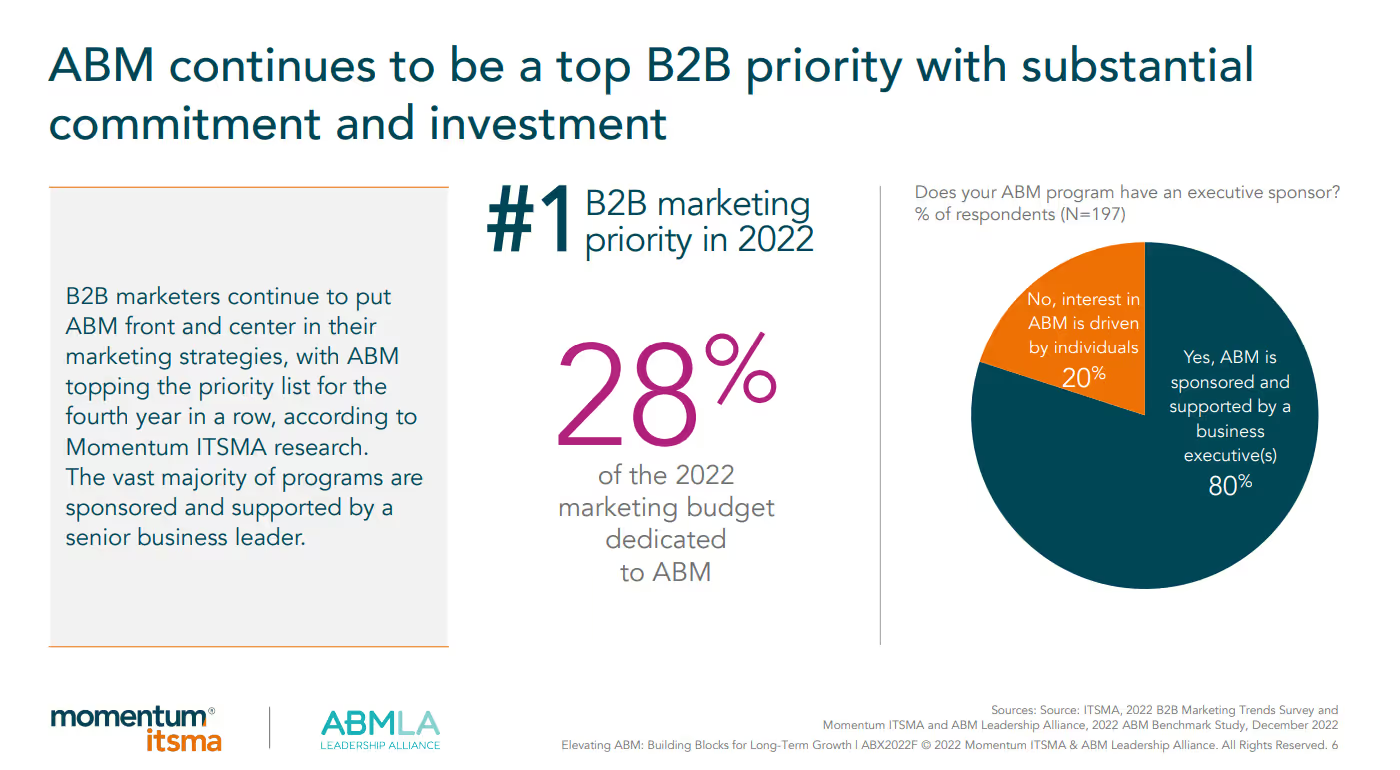
When we worked with Vymo, they needed to generate a $3M pipeline per quarter while penetrating the highly competitive Indian banking and insurance sector.
The challenge? Engaging decision-makers across 50 high-value accounts while maintaining a strong brand presence.
Through a mix of targeted messaging, smart channel choices, and close collaboration between sales and marketing, we helped them generate $21M in marketing-sourced pipeline. Every move was intentional, from how accounts were prioritized to how follow-ups were structured.
Read more → How Vymo generated $21M marketing sourced pipeline using this personalized ABM strategy

Here’s how to put structure behind your ABM strategy, one step at a time.
1. Identify and Prioritize High-Value Accounts
The biggest mistake most SaaS companies make with ABM is casting too wide a net. ABM isn’t about reaching as many companies as possible or reacting to short-term triggers. Account selection should be grounded in long-term fit, revenue potential, and strategic alignment.
Below is a streamlined breakdown of the best practices that ensure account selection drives real pipeline impact, and how Snowflake applies them using data and intent signals.
Best Practice: Use a Data-Driven Approach to Account Selection
High-performing ABM programs select accounts using layered data instead of assumptions.
Here’s how to refine your process:
1. Go Beyond Surface-Level ICP
Firmographic qualities like company size, industry, and revenue are only the starting point. Add deeper layers:
- Firmographic Data: Growth stage and funding history signal long-term fit.
- Technographic Data: Existing tools and integrations help identify compatibility and upsell potential.
- Behavioral Data: Website visits, webinar participation, and ungated research reveal early buying intent.
Snowflake aligns marketing and sales to evaluate accounts on fit, engagement, and organizational complexity, building lists grounded in conversion likelihood and strategic value.
2. Leverage Intent Data:
Tools such as 6sense, Demandbase, and Bombora surface accounts actively researching:
- Competitors
- Product-category content
- Pricing, integration, or ROI details
Snowflake uses Bombora intent signals to prioritize surging accounts and trigger SDR outreach with messaging aligned to active research topics.
3. Segment Accounts by Buying Stage:
Buying readiness varies widely. Tailor outreach accordingly:
- Top-of-Funnel: Thought leadership, industry insights
- Mid-Funnel: ROI calculators, case studies
- Bottom-Funnel: Personalized demos, executive workshops
Snowflake routes accounts to the appropriate program based on a mix of anonymous behavior and CRM insights, accelerating active deals and nurturing early-stage interest.
4. Utilize Predictive Analytics:
Past conversion data reveals:
- Which industries convert fastest
- Who influences deals most
- Which content drives engagement
Snowflake’s predictive scoring identifies high-priority Marketing Qualified Accounts (MQAs) right inside Salesforce, helping SDRs act quickly when buying intent spikes.
Rooted in intent signals, predictive scoring, and stage-based segmentation, Snowflake’s ABM framework helped triple lead-to-opportunity conversions and contributed to its $3.4B IPO.
“We use intent data for account prioritization, topic selection, and understanding subsidiaries... helping us bridge the gap in the 60% of buying cycles that happen anonymously.” — Hillary Carpio, Director of ABM at Snowflake

2. Engaging Decision-Makers at Every Level
SaaS purchases rarely involve one decision-maker. Gartner notes that 6–10 stakeholders typically shape B2B buying decisions, each with unique priorities based on role and influence. Missing even one key voice can cause delayed decisions or stalled deals.

Below is how to identify and engage the full buying committee and how Qlik executes this approach with precision.
Best Practice: Identify and Tailor Messaging to Different Stakeholders
1. Use LinkedIn Sales Navigator
Find decision-makers by filtering job titles, functions, and seniority levels within target accounts.
2. Analyze Historical Deal Data
Study past closed-won opportunities to identify which roles consistently influence purchasing decisions.
3. Conduct Stakeholder Interviews
Current customers help reveal how decisions unfolded, including objections and motivators at each level.
4. Segment Stakeholders by Influence
Prioritize stakeholders with budget authority and high decision-making impact.
Qlik used 6sense’s buying team intelligence to map the full committee within each account and uncover gaps in engagement. This unified view helped sales and marketing direct outreach to roles most likely to shape the final decision.
5. Develop Persona-Based Content Strategies
Tailor messaging to each decision-maker’s concerns:
- CFOs & Finance Teams: ROI models, cost savings, risk reduction
- IT & Security Teams: Compliance, integrations, security validation
- End Users: Ease of use, productivity improvements
- Executives & Sponsors: Competitiveness, scalability, long-term impact
With this visibility in place, Qlik developed persona-specific messaging that addressed each role’s concerns. Content was aligned to where the stakeholder sat in the buying journey, from early education for technical teams to business-case ROI material for executives and finance leads.
Qlik’s ability to align content and outreach with each stakeholder’s role helped reduce time wasted on low-intent accounts by 30–40%.
3. The Multi-Channel, Multi-Touch Engagement Model
SaaS buying cycles are long and require multiple touchpoints. A single interaction rarely drives conversion. An intentional multi-channel approach reinforces value across the buyer journey and increases win probability.
McKinsey reports that companies delivering strong omnichannel experiences are growing market share by at least 10% annually.
Below is how to build this model effectively and how PitchBook used it to accelerate pipeline movement.
Best Practice: Build a Multi-Channel Approach
1. Combine Channels to Sustain Engagement
A coordinated ABM strategy blends:
- Email Sequences: Personalized, behavior-based follow-ups
- LinkedIn Engagement: Meaningful interactions and direct messaging
- Retargeting Ads: Reinforcing messaging after site or email interactions
- Webinars & Events: Industry-specific education for high-intent accounts
- Direct Mail & Gifting: Breaking through digital saturation for top-tier prospects
PitchBook paired outbound sales with ABM ads via RollWorks to ensure consistent exposure across channels.
2. Structure a 90-Day Engagement Plan
High-value accounts should see 8–12 touches over three months, progressing from awareness messaging to personalized demos and high-stakes offers.
PitchBook aligned engagement timing with intent surges, creating tighter coordination between marketing and SDR outreach.
3. Prioritize Using Intent Signals
Platforms like 6sense, Bombora, and Demandbase identify accounts showing active buying behavior. Outreach then focuses on prospects already in-market.
PitchBook used these insights to filter out low-readiness accounts and direct efforts toward those most likely to convert.
4. Automate Personalization at Scale
Tools like Outreach.io, Marketo, and Drift automate delivery while customizing content based on activity, industry, and buying stage.
RollWorks data fed into PitchBook’s automation to keep messaging relevant without manual intervention.
5. Measure What Moves Pipeline
Monitor channel engagement, conversion influence, and drop-off points to refine the approach over time.
PitchBook analyzed ad engagement, site visits, and pipeline influence to continuously optimize campaign design.
This multi-channel orchestration helped PitchBook achieve a faster sales cycle (14.94%), a higher win rate (24.32%), and a 36.85% lift in average deal size. Over 31% of closed-won revenue was influenced by ABM ads.
4. Hyper-Personalization Beyond Generic Outreach
ABM demands tailored messaging that reflects a buyer’s context and priorities. Generic outreach lowers engagement and slows deal cycles. A 2024 Statista study shows 58% of U.S. B2B marketers are optimistic about AI improving personalization, highlighting its growing impact on performance.
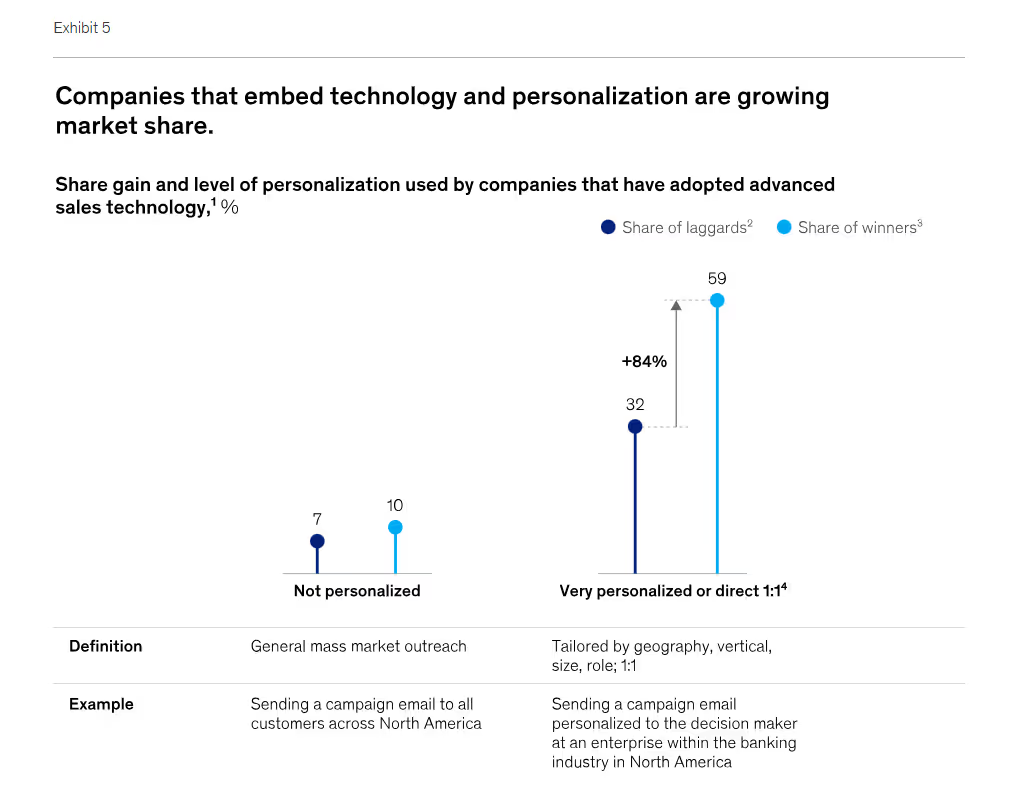
This section explains how to apply personalization across every touchpoint, and how Dialpad used this method to accelerate engagement.
Best Practice: Implement Deep Personalization Across All Touchpoints
1. Account-Specific Content and Reports
Create personalized resource hubs featuring relevant case studies, competitor comparisons, and benchmark-driven insights. These demonstrate clear understanding of a prospect’s challenges and potential improvements.
Dialpad delivered persona-specific ad campaigns that routed stakeholders to tailored feature pages instead of a generic homepage.
2. Personalized Email and Video Outreach
Reference milestones such as funding rounds or leadership shifts in outreach. Short 1:1 videos help humanize communication and strengthen rapport.
By syncing RollWorks intent data with Salesforce, Dialpad customized messaging for high-value personas based on behavior.
3. Dynamic Website and Landing Page Personalization
Use tools like Mutiny and Clearbit to personalize site experiences in real time. Prospects should see role-specific messaging, relevant proof points, and clear paths to next steps.
4. Use CRM and Automation Data
Drift, Outreach.io, and Marketo can dynamically adjust messaging with company names, industry pain points, and recent engagement insights. Tailoring follow-ups based on behaviors such as page visits or content downloads makes progression more natural.
Dialpad’s machine learning audience segmentation ensured the right stakeholders consistently received relevant messaging.
5. Omnichannel Engagement
Ensure messaging remains consistent across email, LinkedIn, ads, and direct outreach. Repetition across multiple touchpoints reinforces value.
6. Social Selling
Engage through comments, shared insights, and relevant content to build credibility with buying committee members on LinkedIn.
Dialpad’s hyper-personalized ABM drove a 10x rise in site visits from target accounts, a 21x lift in engaged accounts, and a 52% faster deal cycle.
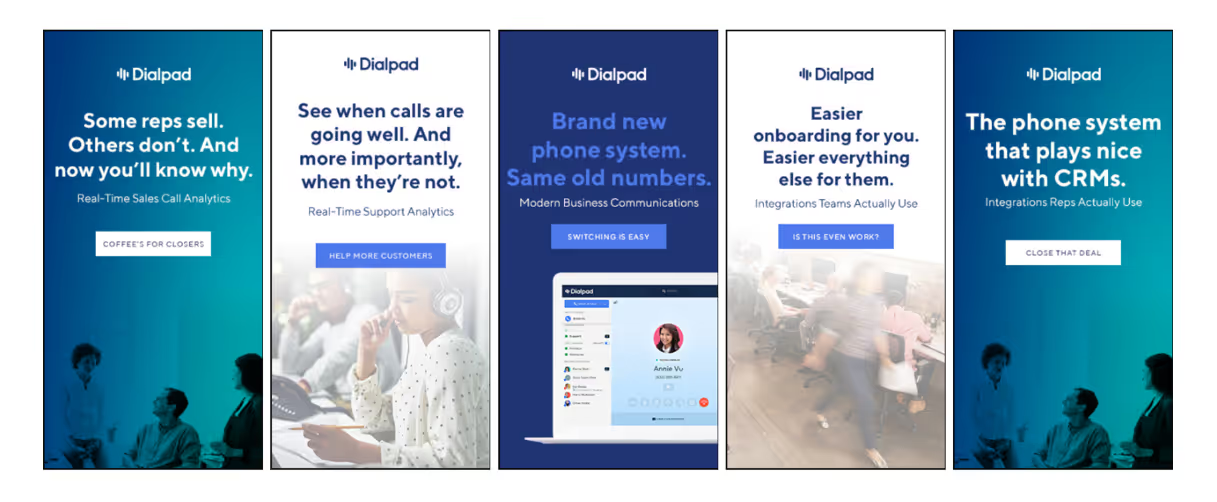
5. Sales & Marketing Alignment
ABM performance depends on tight collaboration between sales and marketing. When marketing surfaces high-value accounts but sales does not act quickly or contextually, engagement drops and pipeline slows. Forrester notes that 26% of ABM programs struggle due to weak sales-marketing alignment.
Below is how to build that alignment and how IBM put these principles into action during its US Open campaign.
Best Practice: Foster Seamless Sales-Marketing Collaboration
Achieving sales-marketing alignment requires structured processes, shared goals, and consistent communication.
Here’s how to create an integrated approach:
1. Joint Account Selection and Unified Data
Sales and marketing must jointly decide which accounts to target, combining qualitative sales insights with marketing’s data-driven evaluation. A unified CRM keeps everyone aligned on buying signals and engagement history.
IBM prioritized more than 9,500 engaged accounts through Demandbase insights, tripling campaign results year over year.
2. Real-Time ABM Dashboards
Shared dashboards in Salesforce, HubSpot, or Marketo give SDRs visibility into how accounts interact with content, enabling timely personalized follow-up.
3. Revenue-Focused Metrics
Rather than measuring activity in silos, both teams align on pipeline influence, opportunity creation, and closed-won revenue as primary ABM success indicators.
4. Consistent ABM Syncs
Regular touchpoints allow teams to refine targeting, share objections faced in live conversations, and respond to shifting account intent.
IBM used ongoing cross-functional analysis during the campaign, enabling better follow-ups while interest was high.
5. Enable Sales with Context
Equip SDRs with battle cards, competitive intelligence, and tailored messaging that reflect account pain points and stage of engagement.
IBM’s team relied on Demandbase personalization data to tailor outreach based on each account's activity on the campaign microsite.
Through structured collaboration, IBM identified 3x more engaged accounts and doubled high-priority prospects surfaced through the ABM motion.

6. ABM Metrics That Matter
Traditional marketing metrics like open rates and impressions provide limited insight in ABM. Since the goal is pipeline and revenue impact, measurement must focus on account progression, multi-stakeholder engagement, and deal influence. In 2023, 71% of companies planned to increase ABM investment, reflecting the need for more measurable outcomes.
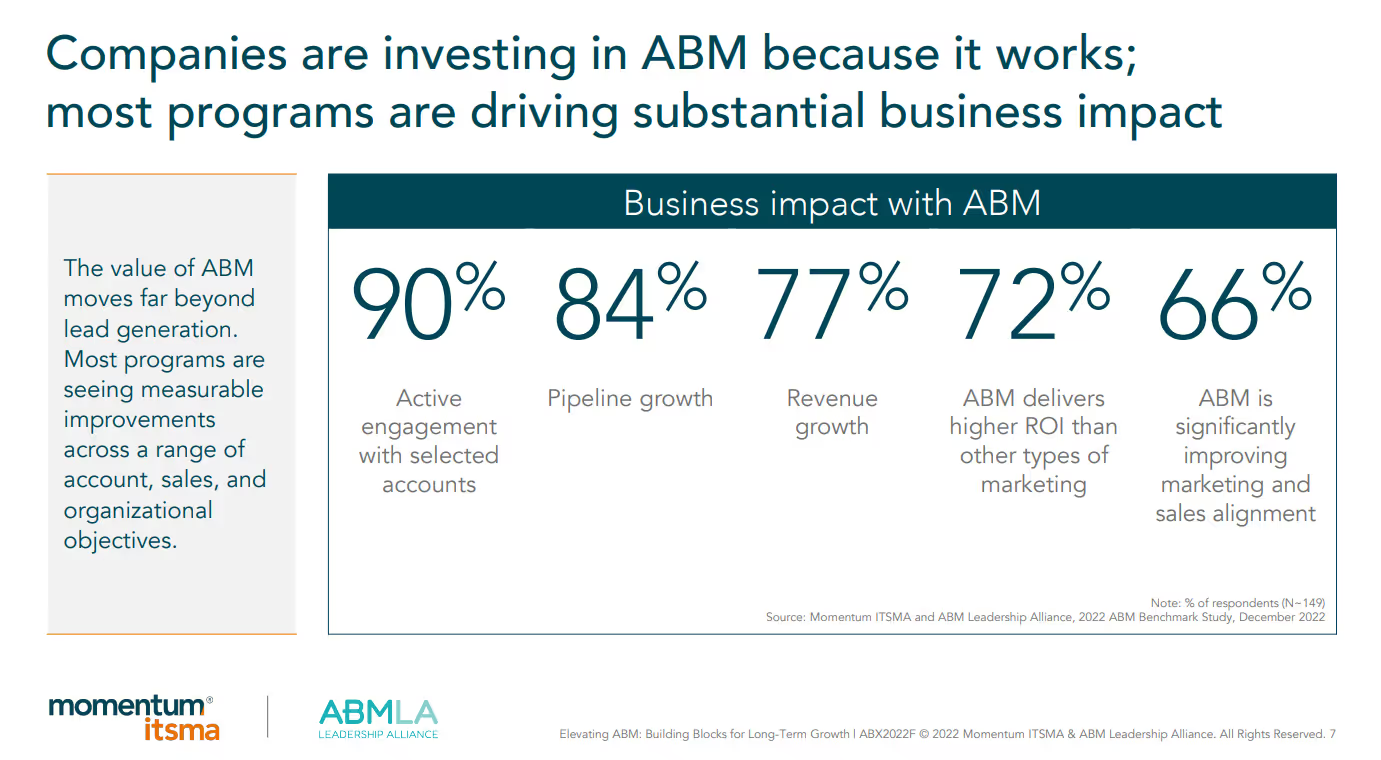
Below are the metrics that best reflect ABM success and how Personify applied them.
Best Practice: Focus on Revenue-Driven ABM Metrics
1. Pipeline Velocity and Account Progression
Track how fast high-value accounts move through stages. Faster progression indicates stronger ABM influence.
2. Multi-Touch Attribution
Connect engagements across ads, email, and events to revenue results. This helps identify which touchpoints move buyers forward.
3. Engagement Scoring
Assign weighted scores to meaningful actions such as demo requests or whitepaper downloads. High-scoring accounts should be prioritized for sales activation.
Personify used RollWorks engagement scoring to differentiate progressing accounts from those needing further nurture.
4. Multi-Stakeholder Engagement
Measure how many stakeholders within a target account interact with content. More engaged roles improves close rates.
5. Closed-Won and Revenue Influence
Rather than counting MQLs, quantify ABM’s impact on sourced or influenced pipeline and revenue.
6. Expansion and Retention
Track renewals, cross-sell, and upsell performance as ABM success extends beyond initial acquisition.
7. Shared Reporting
A unified ABM dashboard ensures both teams act on the same engagement signals, preventing breakdowns in handoffs.
Using Salesforce and RollWorks, Personify gained accurate visibility into sourced pipeline, influenced revenue, and ROI. Their ABM execution delivered an 8.5x return on marketing-sourced revenue and a 39x increase in engaged visitors.

Final Thoughts
ABM success lies in targeting the right accounts, engaging them through multiple touchpoints, hyper-personalizing outreach, and aligning sales and marketing efforts.
The most successful SaaS companies in 2025 will be those that prioritize quality over quantity in account selection, implement highly personalized and data-driven engagement strategies, align sales and marketing to drive revenue-focused ABM initiatives, and use meaningful ABM metrics to track and refine strategies.
Ready to elevate your accounts-targeting with these ABM best practices? Let’s make it happen with your personalized ABM strategy!



.svg)



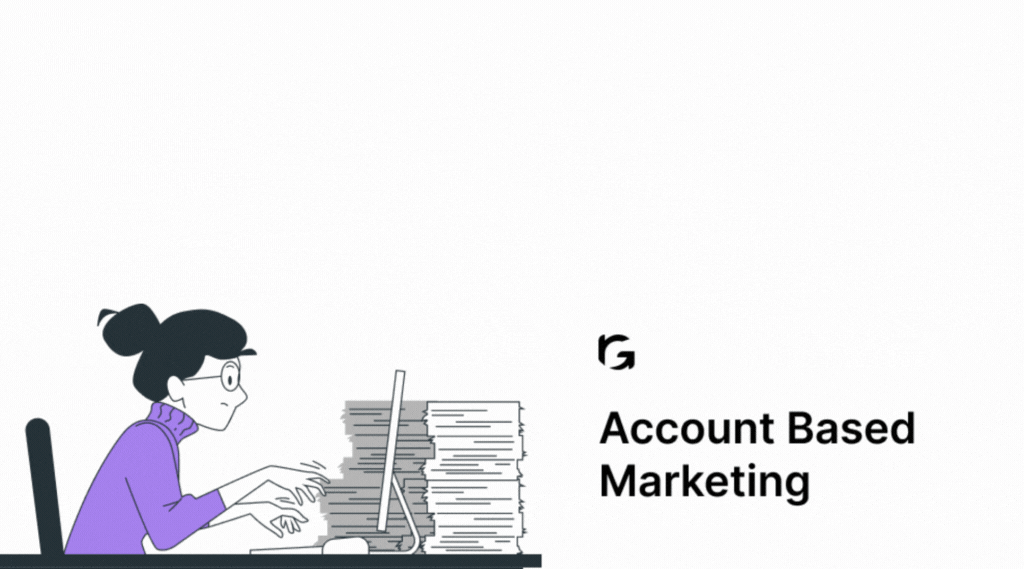
.webp)